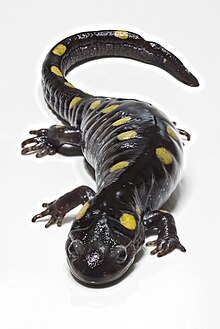
Back Salamander Afrikaans Caudata AN سلمندر Arabic سلمندر ARZ Caudata AST Suda-quruda yaşayan quyruqlular Azerbaijani Salamander BBC Хвастатыя земнаводныя Byelorussian Хвастатыя земнаводныя BE-X-OLD Опашати земноводни Bulgarian
| Salamanders | |
|---|---|

| |
| Spotted salamander, Ambystoma maculatum | |
| Scientific classification | |
| Domain: | Eukaryota |
| Kingdom: | Animalia |
| Phylum: | Chordata |
| Class: | Amphibia |
| Clade: | Caudata |
| Order: | Urodela Duméril, 1806 |
| Suborders | |

| |
| Native distribution of salamanders (in green) | |
Salamanders are a group of amphibians typically characterized by their lizard-like appearance, with slender bodies, blunt snouts, short limbs projecting at right angles to the body, and the presence of a tail in both larvae and adults. All ten extant salamander families are grouped together under the order Urodela from the group Caudata.[2] Salamander diversity is highest in eastern North America, especially in the Appalachian Mountains; most species are found in the Holarctic realm, with some species present in the Neotropical realm.
Salamanders never have more than four toes on their front legs and five on their rear legs,[3] but some species have fewer digits and others lack hind limbs. Their permeable skin usually makes them reliant on habitats in or near water or other cool, damp places. Some salamander species are fully aquatic throughout their lives, some take to the water intermittently, and others are entirely terrestrial as adults.
This group of amphibians is capable of regenerating lost limbs as well as other damaged parts of their bodies. Researchers hope to reverse engineer the regenerative processes for potential human medical applications, such as brain and spinal cord injury treatment or preventing harmful scarring during heart surgery recovery.[4] The remarkable ability of salamanders to regenerate is not just limited to limbs but extends to vital organs such as the heart, jaw, and parts of the spinal cord, showing their uniqueness compared to different types of vertebrates. This ability is most remarkable for occurring without any type of scarring. This has made salamanders an invaluable model organism in scientific research aimed at understanding and achieving regenerative processes for medical advancements in human and animal biology.[5]
Members of the family Salamandridae are mostly known as newts and lack the costal grooves along the sides of their bodies typical of other groups. The skin of some species contains the powerful poison tetrodotoxin; these salamanders tend to be slow-moving and have bright warning coloration to advertise their toxicity. Salamanders typically lay eggs in water and have aquatic larvae, but great variation occurs in their lifecycles. Some species in harsh environments reproduce while still in the larval state.
- ^ Anderson, J. S. (2012). "Fossils, molecules, divergence times, and the origin of Salamandroidea". Proceedings of the National Academy of Sciences. 109 (15): 5557–5558. Bibcode:2012PNAS..109.5557A. doi:10.1073/pnas.1202491109. PMC 3326514. PMID 22460794.
- ^ Frost, Darrel R. (2023) [1998]. "Caudata". Amphibian Species of the World. American Museum of Natural History. Archived from the original on 22 March 2023. Retrieved 22 March 2023.
- ^ Life Traces of the Georgia Coast: Revealing the Unseen Lives of Plants and Animals
- ^ "Missing Parts? Salamander Regeneration Secret Revealed". Live Science. 20 May 2013. Archived from the original on 16 July 2018. Retrieved 15 July 2018.
- ^ Zhong, Jixing; Aires, Rita; Tsissios, Georgios; Skoufa, Evangelia; Brandt, Kerstin; Sandoval-Guzmán, Tatiana; Aztekin, Can (10 October 2023). "Multi-species atlas resolves an axolotl limb development and regeneration paradox". Nature Communications. 14 (1): 6346. Bibcode:2023NatCo..14.6346Z. doi:10.1038/s41467-023-41944-w. PMC 10564727. PMID 37816738.
© MMXXIII Rich X Search. We shall prevail. All rights reserved. Rich X Search